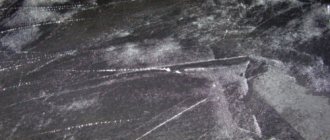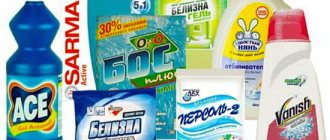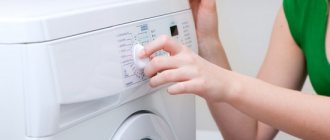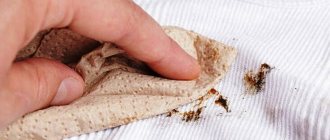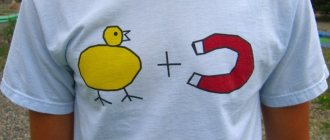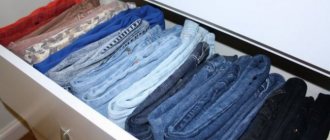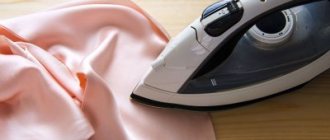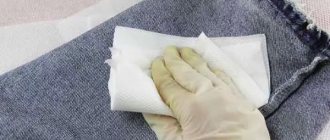A plastic jelly-like mass with unique physical properties is capable of stretching, flowing, becoming dense and even bouncing off hard surfaces.
When it gets on the fabric, the mucus spreads, penetrates deeply into the structure of the fibers and gradually dries out. This causes a lot of trouble for mothers. Removing traces of children's play from textiles at home is a difficult task.
We'll tell you in this article how to remove slime from fabric - blankets, rugs, jeans and other things.
How to remove using mechanical methods?
If a large piece of slime has stuck to the fabric, it is not recommended to wash the item immediately. The sticky mass does not dissolve in water and will remain on the surface. It is necessary to clean it off as quickly as possible.
Suitable for this:
- brush;
- wooden spatula;
- plastic spatula;
- butt (blunt side) of the knife;
- a plastic card;
- tool for working with plasticine.
Sharp objects (knife blade, scissors) will cut through the sticky mass faster, but the risk of damaging the material will increase significantly.
Some housewives use tape or pieces of slime. It is enough to stick the product to the contaminated area, sharply tear it off and repeat until all the substance has left the tissue.
Even dried slime can be removed mechanically. The method is fundamentally not suitable for delicate fabrics; for them it is better to use freezing.
Professional chemical cleaning
But there are situations when even serious household chemicals are powerless. After all, neither strong chemicals nor improvised means are suitable for working with delicate fabrics. Silk, viscose, lace and similar materials require special care, which means cleaning too. Of course, dry cleaning is not cheap, but if the item is dear to you, it’s worth it.
Slime on clothes is not a pleasant thing. But there’s no point in getting upset or scolding the little troublemaker, because the situation is fixable. Moreover, from this article you learned at least 12 ways to solve it.
Thermal impact
Like chewing gum and plasticine, slime is sensitive to temperature changes. These properties will help get rid of sticky mass from almost any fabric.
Before using the method, you must try to remove the maximum amount of substance from the surface mechanically.
Heat
Denim, cotton and linen products tolerate high temperatures well. You can remove the remaining slime on them using boiling water, then the sticky mass will become liquid.
Step-by-step instruction:
- Clean off any remaining slime mechanically.
- Pour boiling water into a container (basin, bowl).
- Soak the item and wait until the water cools to room temperature.
- Machine wash with stain remover added.
You can enhance the cleaning efficiency with ammonia. It is enough to add 1 tsp to the soaking container. The method has a significant drawback - large items (furniture, heavy curtains) cannot be cleaned this way.
It is imperative to study the manufacturer's recommendations for caring for the product on the label. Fabrics with natural composition may shrink after contact with boiling water.
Freezing
The method is universal, it can be used even for natural wool, viscose, silk and knitwear. The slime hardens under low temperatures and is easily separated from the fibers. Delicate fabrics will not lose their appearance and will not become deformed.
Algorithm of actions:
- Place the product in a plastic bag.
- Place in the freezer.
- Leave for 3-4 hours until the substance hardens.
- Clean off pieces of slime mechanically.
If the product is large (sofa, carpet), you can use ice cubes. It is enough to place them in a bag and apply them to the affected area.
How to remove slime from hair
Slime can really cause a lot of problems if it sticks to your hair. Many people immediately take up scissors, however, you can remove the slime in simple ways.
With oil
Take vegetable oil, Vaseline, rich cream or baby oil. Apply generously to hair where it is dirty. Use a fine-toothed hair comb to comb out the anti-stress hair, adding oil periodically. When the bulk is removed, wash your hair with laundry soap and hot water.
With ice
If you have a small piece of slime or hand gum stuck to your hair, you can try freezing it. Apply ice cubes to the stained strand and wait a little. When the anti-stress freezes, it will become hard and brittle. It will be easy to pull it out by hand or comb it out with a comb.
Slime in hair
How to remove contamination with folk remedies?
After removing the main part of the slime from the textile surface, a colored and greasy mark remains. Components that can be found in every housewife’s arsenal will help you get rid of them.
Not all products are equally effective; for example, vegetable oil does a good job of removing slime residue, but leaves behind a characteristic stain that is not so easy to remove.
Laundry soap
If slime has recently gotten on the fabric, a universal budget product will help get rid of it - laundry soap containing 72% fatty acids. It copes with almost any type of pollution.
Instructions for use:
- grind the product using a grater or knife;
- add water to the shavings until a paste forms;
- treat the stain with the product and leave for half an hour;
- remove the product with a damp cloth;
- Rinse the treated area thoroughly with clean water.
Soap shavings should be diluted with boiling water; the product should be applied to the fabric surface after it has cooled. The procedure must be repeated until the problem disappears completely. If you don't have the product you need at home, you can replace it with a few drops of dishwashing liquid.
Organic solvent
To fix the problem, use gasoline, purified kerosene, or acetone-based nail polish remover.
Instructions for use:
- Place the product on a flat surface.
- Place napkins under the contaminated area.
- Apply the product to a tampon, rag or napkin (preferably white).
- Treat the stain, moving from the edge to the center.
- Wash the product using conditioner.
It is better to work with aggressive liquids with gloves, and protect your respiratory tract with a mask or respirator. Drying must be done in fresh air to get rid of the specific odor.
Medical alcohol
Housewives use the product in pure form or in solution, it depends on the type of fabric. Mode of application:
- place the item on a hard surface;
- place napkins under the area that requires treatment;
- moisten a rag with alcohol and apply to the stain;
- rinse the surface with clean water after 15-20 minutes;
- wash the product in the usual way.
The product effectively removes fresh and old stains, but is not suitable for delicate fabrics (especially silk). Medical alcohol can be replaced with isopropyl alcohol, the quality of cleaning will not be affected.
Several ways to clean carpet from slime
So, the piece of furniture is dirty, how to remove slime from the carpet? Here are some cleaning methods:
- Handgam hit the carpet and had not yet had time to soak in. How to clean slime? Collect it, perhaps, with the toy itself. Take a large piece and press it onto the greasy stain, sharply tear it off the surface, repeat until the particles are completely removed from the carpet. Scrape off the dried pieces very carefully.
- You can rub the stains with hydrogen peroxide or laundry soap.
- Stain removers for carpets are added to water, the resulting foam is applied with a brush to the carpet, and when the work is completed, vacuumed.
- The slime leaves an oily residue behind; use kitchen dishwashing liquid to remove it.
- Soak a cloth in alcohol and rub vigorously.
- Using starch or table salt will help remove the greasy residue. Sprinkle it generously onto the affected area, then brush off with a stiff clothes brush.
Professional compositions
Residual slime stains from textile surfaces can be removed with industrial products that are used to remove chewing gum and paints and varnishes. Housewives recommend:
Dr. Beckmann Office and hobby
Universal stain remover . Effectively fights residues of chewing gum, glue and paint. Does not contain phosphates and chlorine. The release form is bottles with liquid, there are bottles with a convenient roller. Price from 170 rubles for 50 ml. Read reviews here.
Vanish Oxi Action
Surfactant-based concentrate for removing stains. The product is used for pre-treatment of dirt, soaking and main washing. Does not contain chlorine, safe for delicate fabrics. Price 340 rubles per 1 liter. Read reviews here, here and here.
WD-40 or RW-40
Universal spray lubricant from automotive stores . Contains mineral oil and white spirit. Removes sticky mass from the surface without difficulty, but leaves a characteristic greasy residue that must be removed. Price from 320 rubles for 450 ml.
When choosing an industrial product, you must carefully study the instructions on the packaging so as not to spoil the fabric fibers.
How to clean slime from carpet or upholstered furniture
As in all other cases, the first thing to do when you find a stain on a carpet or sofa is to remove the remaining substance mechanically. You need to scrape the stain from the edges to the center, and not vice versa!
There are different methods for further cleaning.
Folk remedies
- Laundry soap. Generously soap the carpet or furniture where it is dirty and leave for an hour. Use a brush or sponge to remove any remaining slime and wipe the stain with a damp cloth.
- Dishwashing liquid. Squeeze enough detergent onto the stain so that it covers the entire surface of the stain with a layer of 1–2 mm. Leave for two hours and finish cleaning with a sponge and damp cloth.
- Ammonia. It is enough to leave it on the site of contamination for 5–10 minutes. But! Ammonia can harm some carpets, discoloring not only the stain, but also the pile itself. Therefore, before using it, it is better to test ammonia on a small area of the carpet in an inconspicuous place (corner).
Chemicals
When starting to work with chemicals, be sure to follow the following rules:
- Gloves. Even if the product is not very aggressive, rubber gloves will still not harm you. Chemistry is chemistry, and its contact with the skin of your hands will not bring anything good. You can get away with mild irritation or allergies, or you can get a chemical burn, so it’s better to be safe.
- Instructions. Read the instructions on the label carefully. It will indicate the required dosage for certain types of contaminants, the necessary safety measures, and many other important nuances. By the way, if you use more detergent than necessary, you can burn a white stain on colored clothes.
- Fabric type. Ask the seller to help you choose a stain remover for the exact fabric you are going to clean. For different types of fabric - different chemicals, otherwise the product may either not work or act too strongly and ruin the material.
The following products are most effective for cleaning slimes and handgams:
- Antipyatin;
- Spray Help;
- Vanish Oxi Action.
The product is applied according to the instructions on the package, after which it is removed with a damp cloth. Some household chemicals can also affect the color of your carpet and furniture! We recommend testing it first in an inconspicuous place.
Detergents for removing stains from carpet
Ice
If you place an ice pack on a slime stain, it will freeze and can be removed mechanically.
Cleaning clothes
If the sticky mass gets on a piece of clothing, you can use one of the methods suggested above.
The algorithm of actions will always be the same:
- Remove particles of sticky mass that did not have time to penetrate the fabric using mechanical means.
- Get rid of remaining slime using the chosen method (freezing, soaking in boiling water, soap solution, active substances, stain removers).
- Wash the product and dry it.
It is necessary to choose a stain remover taking into account the type of fabric, the size of the product and the manufacturer’s recommendations on the label.
This video will show you how to remove slime from clothes:
Cold way
Sometimes not only stains from the slime remain on clothes, but also the toy itself, since its composition allows the particles to spread and penetrate the fibers. A freezer and a piece of ice will help with this.
By freezing
If the slime is on clothes, then you can remove it in a simple way: you need to place the item in the freezer and leave it for several hours (2-4). Then the problem area is cleaned with a knife or scissors. The slime will become brittle and easy to scrape off, but this must be done carefully so as not to damage the fabric itself.
With ice
If it is not possible to place spoiled clothes in the freezer, then you can use ice cubes - they simply cover the stuck toy with them, periodically change them to “fresh” ones and achieve stable solidification of the mass.
After removing the slime, stains may remain on the fabric; they are removed using one of the methods suggested in the article - cleansing with a knife, then washing. If the slime was large and spread across the clothes in a large stain, then during its removal the toy may “melt”, in which case you will need to repeat the procedure with freezing.
Features of cleaning various textiles
The choice of cleaning method directly depends on the composition of the fibers of the material affected by the sticky mass. Freezing is suitable for any textile products, but there are recipes that are used only for certain groups.
Jeans, cotton, linen
Natural fibers of plant origin are resistant to aggressive components. Can be soaked in boiling water, processed:
- laundry soap;
- medical and ammonia alcohol;
- solvents;
- table and apple cider vinegar;
- kerosene, gasoline;
- industrial products (stain removers, refrigerants).
Organic solvents must be used carefully so as not to discolor the fabric.
Silk, wool, guipure
To clean delicate fabrics from slime, the following are most often used:
- freezing method;
- solutions based on laundry soap or dishwashing detergent;
- industrial stain removers.
Professionals do not recommend using acidic solutions containing lemon juice, vinegar and alcohol (ammonia is especially dangerous). Treatment with hydrogen peroxide is fundamentally unsuitable for silk.
Items made of knitwear, viscose, synthetics
The best way to get rid of sticky mass on such fabrics is to use household chemicals. You should choose a stain remover taking into account the composition and color of the material . The safest folk remedies are freezing and subsequent treatment with soapy water.
The mechanical method of pre-cleaning is absolutely not suitable for knitted fabrics; they are more susceptible to deformation.
Rustle or carpet
Slime that gets onto the carpet can be easily removed by mechanical scraping after drying or freezing with ice. Industrial carpet cleaning products work well to remove residual stains.
Step-by-step instruction:
- add the liquid to the water and foam well;
- Apply a generous layer of foam to the stain and rub with a sponge;
- blot the area with a napkin to remove excess moisture;
- remove residues with a vacuum cleaner.
Suitable folk remedies:
- soapy,
- acetic,
- alcohol solution,
- organic solvent.
The method of application is identical. The solvent is not recommended for use on synthetic surfaces.
This video will show you how to clean slime from a carpet:
Plaid
It is more difficult to remove non-Newtonian fluid from a fleecy surface. The mechanical method is not suitable, as there is a risk of damaging the fibers and ruining the product. Exposure to low or high temperatures is also difficult.
In this case, it is necessary to choose an effective industrial or folk remedy and use it according to the instructions:
- If possible, remove large particles of slime.
- Moisten the stain with a small amount of water.
- Apply the cleaner to a rag and treat the textile surface.
- Rinse the area with clean water.
- Dry the product.
Treatment of stains is always carried out from the edge to the center so that the size of the stain does not increase. In order not to spoil the blanket, the product must first be tested on an inconspicuous area.
From furniture upholstery
It is more difficult to clean armchairs, sofas, and mattresses from the jelly-like mass due to their large size. In addition, contact with large amounts of moisture is contraindicated for products. The best way is to use professional dry cleaning services.
If the housewife decides to carry out the procedure on her own, it is necessary to act locally, be careful and observe the following points:
- Remove pieces of slime mechanically.
- Treat the surface with one of the products described above (stain remover, homemade solution).
- Rinse the area with clean water.
- Let the fabric dry.
When cleaning the sofa, you should remember that you cannot pour detergent or clean water onto the surface. The liquid must be applied to a rag or napkin and treated with it.
From outerwear
Jackets and coats are cleaned using methods that are used for clothing, but the large size does not allow the product to be placed in the freezer.
Things can be placed on the balcony at sub-zero temperatures or use ice cubes in a plastic bag. After 2-3 hours, you can use the mechanical cleaning method and remove the residual stain using any of the suggested means.
A solvent will help remove the sticky mass from fur lint. It is necessary to apply the product to the sponge and treat the damaged area.
Ways to remove slime
Freezer
- Place the soiled clothing in a plastic bag, release all the air, and tie it tightly.
- Place the bag in the freezer for 3-4 hours.
- Then take out your clothes and use a sharp tool to remove the slime from them.
Hot processing
Boiling water will dissolve the slime. It is enough to pour boiling water over the soiled item and leave for a third of an hour. Then wash as usual.
Not every fabric can withstand high temperatures.
Study clothing labels. If it is marked “30 °C”, use the freezer.
Laundry soap
Soap can be used on dark and white fabrics. To remove traces of slime, rub it with soap, soak, and leave for 1–2 hours. If necessary, repeat the procedure 2-3 times. You can also make soap slurry by diluting grated soap with a small amount of water.
Salt
- Dilute a tablespoon of salt with water to a paste.
- Rub the resulting mixture onto the stain and leave for 2–3 hours.
- Soak the cloth in salt water (a tablespoon per 1.5 liters of water), leave overnight.
- Then wash as usual.
A mixture of salt, lemon juice and ammonia
Mix all ingredients in equal quantities until a paste forms. Apply the mixture to the stain. If the dirt is fresh, just rub it. An old stain will have to be soaked in the pulp for several hours, after rubbing it with a brush. Afterwards wash by hand.
Alcohol
To remove slime you need isopropyl alcohol. It is suitable for cotton and linen clothing. Apply alcohol to the stain with a cotton pad and rub well. The product works quickly, the item can be machine washed after 15 minutes.
Acetone
This substance is suitable for cleaning outerwear and fleecy fabrics. The method of using the liquid is the same as in the previous case. After treatment, the slime easily comes off the villi.
Do not use acetone on natural fur.
Petrol
In this case, only purified gasoline is used.
Dampen a cotton pad, bandage or piece of cloth with gasoline and wipe the stain. After treatment, clothes should be washed several times with rinse aid to remove odors.
Hydrogen peroxide
Blot the contaminated area with a cotton swab soaked in peroxide. Rub for at least 10 minutes, moving from the center of the stain to the edges, then rinse the item. Next, you will need to wash the item in the machine.
Dish detergent
Fill the stain with any dishwashing detergent (“Fairy”, “Sarma”, “Sorti”, “Myth”). Rub gently into the fabric and leave for 1-2 hours. Then rub the stain again and rinse with warm water. The slime goes away completely after two or three procedures.
Special products, anti-lickers
If folk remedies fail to deal with the slime, household chemicals will come to the rescue:
- Dr. Beckmann is a strong stain remover that will dissolve remaining slime without corroding the fabric or leaving marks. After treatment, the item must be washed and rinsed thoroughly.
- Vanish. It will not be able to dissolve the slime itself, but it can remove the greasy stain after the slime.
- Runway RW-40. They use it when the slime is very ingrained and gentle remedies do not work. The spray is applied in a thick layer, rubbed into the fabric with a cotton napkin, and then the item is washed in a machine.
Recommendations from professionals
To remove non-Newtonian fluid from fabric, you must follow simple rules:
- Prepare the room in which the procedure will be carried out. Open the windows, turn on the ventilation. Constant air circulation is especially important when working with volatile substances and acids.
- Take care, if necessary, to protect the skin of the hands, upper respiratory tract and mucous membranes. A mask or respirator, rubber gloves will allow you to get rid of specific contamination without harming your health.
- Assess the size of the soiled item and prepare a container that matches its size (bowl, basin, bathtub). If you only have to clean a small part of the surface, you should not soak it all.
- Select a cleaning agent based on the type of material. Delicate fabrics do not tolerate contact with aggressive components and prolonged mechanical impact.
- Read the instructions on the detergent label and treat the surface in accordance with the manufacturer's recommendations.
- Avoid prolonged rubbing and brushing of delicate fabrics (silk, organza, natural wool). Wash with gentle movements, without pressure.
- Rinse the product several times after cleaning. Most active ingredients are poorly washed out of the fibers and can further cause skin irritation.
If an expensive item made of thin, delicate fabric has been damaged, it is advisable to turn to professionals. Dry cleaning services are not free, but they will help preserve the product.
How to remove slime from bed linen or blanket
- Glycerin, turpentine and ammonia. Mix 2 tbsp. l. glycerin, 3 tbsp. l. turpentine and 3 tbsp. l. ammonia. This mixture is well suited for cleaning colored items, as it gently removes stains without affecting the color of the fabric itself. Apply it to the stained area and leave for 2-3 hours, after which simply wash in any convenient way.
- Ammonia and peroxide. Mix alcohol and hydrogen peroxide in a 1:1 ratio and pour generously onto the stain. After 5-10 minutes, wash the item in the washing machine or by hand. If necessary, repeat the procedure several times. This method is best applied to cotton products.
- Coca Cola. Wash the item stained with slime by mixing any washing powder with Coca-Cola in a 1:1 ratio. This can be done either manually, in a basin of warm water, or in a washing machine.
Removing handgams from fabric
How to clean a carpet, upholstered furniture, rug?
Are you trying to unstick a bright toy from a fleecy surface, but it comes off only with the material? You cannot immerse a floor covering, a sofa or a wool blanket in a bowl of boiling water and put it in the washing machine. And ammonia, hydrogen peroxide, kerosene and especially acetone can ruin the material. What to do?
We recommend that you purchase special products for cleaning carpets and textiles at a household chemicals store.
The following products have positive reviews:
- Nordland active foam;
- Help spray;
- Udalix Ultra powder;
- Antipyatin stain remover soap;
- Vanish Oxi Action shampoo.
First, peel off as much of the slime as you can from the surface of the carpet, blanket, or furniture. Then apply the chemical and leave until the stain has dissolved (usually 30 minutes). Wipe the area first with a damp cloth and then with a dry cloth.
We recommend: Coffee and coffee grounds in everyday life: absorbent, flavoring, pesticide
There is another option for saving the carpet: attach a strong plastic bag with ice cubes to the slime. The toy will harden in 5-10 minutes. Then try to carefully scrape it off with a knife or nail file.
